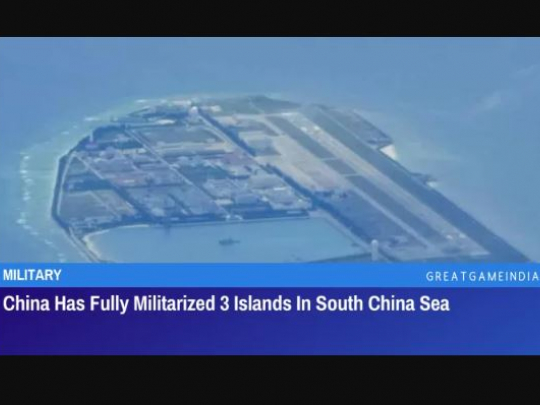China Has Fully Militarized 3 Islands In South China Sea

 A study in which the legitimacy of China’s maritime assertions in the South China Sea was branded as “inconsistent with international law,” was recently published. The study highlights how China has fully militarized 3 islands in the South China Sea.
A study in which the legitimacy of China’s maritime assertions in the South China Sea was branded as “inconsistent with international law,” was recently published. The study highlights how China has fully militarized 3 islands in the South China Sea.
According to Adm. John Aquilino, chief of US Indo-Pacific Command, China has completely militarized at least three of the islands it constructed in the contentious South China Sea.
“I think over the past 20 years, we’ve witnessed the largest military buildup since World War II by the PRC [People’s Republic of China],” Aquilino told The Associated Press. “They have advanced all their capabilities and that buildup of weaponization is destabilizing to the region.”
According to Aquilino, China has armed Mischief Reef, Subi Reef, and Fiery Cross Reef with anti-ship and anti-aircraft missile devices, as well as laser and jamming technology and aircraft hangars. He went on to say that the missile systems could readily target any civilian or military aircraft traveling over the contested waters.
“So that’s the threat that exists, that’s why it’s so concerning for the militarization of these islands,” Aquilino said. “They threaten all nations who operate in the vicinity and all the international sea and airspace.”
Aquilino’s current objective, according to him, is to “prevent war” via deterrence and foster peace and stability, which entails negotiating with US allies and partners.
“Should deterrence fail, my second mission is to be prepared to fight and win,” Aquilino said.
Aquilino, as head of US troops in the Indo-Pacific, is in charge of the Pentagon’s biggest combatant command, which includes 380,000 soldiers, sailors, Marines, airmen, guardians, Coast Guardsmen, and civilians.
In a geopolitical conflict over reefs, islands, and atolls in the South China Sea, China’s ruling communist party is presently at odds with Brunei, Malaysia, the Philippines, Vietnam, and Taiwan.
Boats beside Chinese structures and buildings on the man-made Fiery Cross Reef at the Spratlys group of islands in the South China Sea on March 20, 2022. (Aaron Favila/AP Photo)
Although the US does not have a claim to the disputed territories, it has sent warships through the vicinity on “freedom of navigation” operations.
The Chinese regime’s “nine-dash line” claim over nearly 85 percent of the South China Sea’s 2.2 million square miles was denied in a 2016 international verdict. China’s claims had no factual precedent, according to the verdict, and Beijing had breached Philippine independence by making territorial assertions with its artificial islands constructed on reefs and sea rocks.
The decision has been contested by the Chinese Communist Party (CCP). To terrorize foreign vessels, restrict entry to waterways, and seize shoals and reefs, it has sent coast guard ships and Chinese fishing boats, some of which have military-trained fisherman on board.
Aquilino praised the Philippines for pushing the territory issue to international arbitration, calling it an excellent model for peaceful resolution.
Aquilino spoke with the Associated Press while flying near China-held outposts in the Spratly archipelago aboard a US Navy surveillance plane, the P-8A Poseidon.
According to the Center for Strategic and International Studies in Washington, China has seven outposts in the Spratly Islands and twenty in the Parcel Islands.
Throughout the voyage, Chinese callers constantly warned the US Navy aircraft to depart what they claimed was Chinese territory.
“China has sovereignty over the Spratly islands, as well as surrounding maritime areas. Stay away immediately to avoid misjudgment,” one of the Chinese radio messages said in a veiled threat.
In response, a U.S. pilot on the Navy plane radioed back to the Chinese, saying, “I am a sovereign immune United States naval aircraft conducting lawful military activities beyond the national airspace of any coastal state.”
“Exercising these rights is guaranteed by international law and I am operating with due regard to the rights and duties of all states.”
A study (read below) on the legitimacy of China’s maritime assertions in the South China Sea was published by the US State Department in January. The accusations are “inconsistent with international law,” according to the report.
“In the name of enforcing its expansive and unlawful maritime claims in the South China Sea, the PRC is interfering with rights and freedoms, including navigational rights and freedoms, that are due to all states,” said Constance Arvis, acting deputy assistant secretary for oceans, fisheries, and polar affairs, at a press conference following the study’s release.
- Source : GreatGameIndia


















